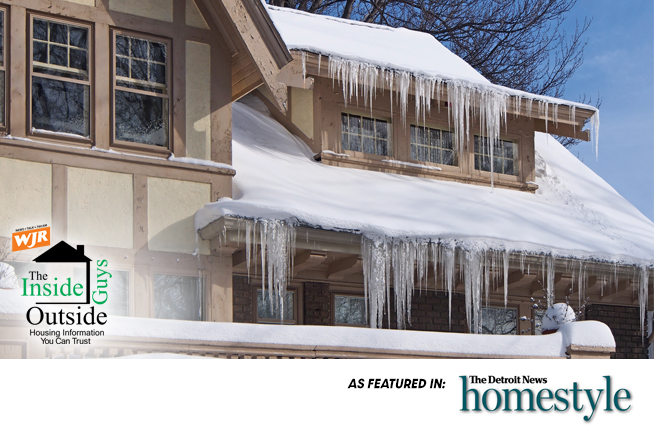
By Ken Calverley and Chuck Breidenstein
DETROIT, December 9, 2021 ~ Tis the season for ice and all the related potential damage that it can cause.
The Guys get a lot of questions regarding ice on the roof; something every homeowner has to deal with at some point.
Q. What is an ice dam?
A. A ridge of ice that forms on the cold overhang of your roof running parallel to the eaves.
Water that melts from the roof will pool behind this ice and can then work its way up and under rows of shingles. Remember that shingles are intended to shed water, not hold it.
Q. What causes ice dams?
A. Our houses lose heat through the attic space. More heat is lost where there is less insulation in the attic. That thermal weak spot is right where the exterior walls meet the roof rafters. Just above this point a lot of heat will melt snow on the roof. Just below this point is the coldest portion of your roof – the overhang where cold winter air can move around all three surfaces and cause melt water to re-freeze creating the ice dam.
Q. Can ice dams be prevented?
A. In most homes the answer is “not realistically.” In our severe weathering climate, conditions can occur within hours where sunlight contributes to snow melt and a hard freeze that night creates the ice ridge. We also see situations where we accumulate snow on the roof which creates an insulation layer above the shingles – where heat is melting the bottom layer of snow and creating a runoff which re-freezes at the eave.
Virtually any building, in the right conditions, can experience ice damming.
In newer homes builders have learned to create more and better ways to thermally insulate the weak spot we discussed, minimizing the opportunity to melt roof snow through heat loss. Additionally, professional roofing companies have developed new and better ways to ventilate attic spaces to help direct lost heat to the ridge of the roof.
Q. How can we prevent leaks from ice dams?
A. Professional roofing companies install a product that mimics rolled rubber in layers above the eaves on the roof. This “eaves flashing” lays beneath the shingles and forms a secondary waterproof barrier and water shed so that water that gets beneath the shingles will be directed off the roof – not into your home.
While code now requires a minimum installation coverage for this product, professionals will install more of it and exceed code.
Q. Can my gutters contribute to ice dam formation and subsequent leaks?
A. Absolutely! Blocked gutters will allow water to back up and freeze. This same condition can also cause the gutters to disconnect from the home due to the weight and force of the ice. This is a major reason the Guys are always talking about properly sized, installed and maintained gutter systems.
Q. Can leaks from ice dams show up as leaks around my ceilings, windows and doors?
A. Yes. This is very common. Because that weak spot we discussed is at the top of exterior walls, it is common for infiltrating water to run down the underside of the roof and enter the wall cavities. The top of a window or door in the wall may cause this water to pool, collect and leak through trim and around wall finishes.
Q. What can I do to minimize damming effects?
A. Aside from the things we’ve discussed, installation of quality heat tapes by licensed professionals can keep the water flowing through a dam. These tapes can be switch or temperature controlled. The guys also talk about using “salt socks” – old socks filled with magnesium chloride and tied to fishing line or nylon string before being tossed up onto the ice dams. The salt will melt drainage rivulets into the dam and can help.
Keep in mind that good attic insulation and ventilation combined with water barrier underlayment at the eaves can go a long way toward minimizing ice dam issues.
Use the professionals you’ll find atInsideOutsideGuys.com to help protect your roof and your home.
WJR TOP STORIES:





